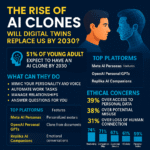Now Reading: AI Multimodal vs Multisensory: What It Means and Who’s Leading the Race in 2025
-
01
AI Multimodal vs Multisensory: What It Means and Who’s Leading the Race in 2025
AI Multimodal vs Multisensory: What It Means and Who’s Leading the Race in 2025

🧠 AI Multimodal vs Multisensory: What It Means and Who’s Leading the Race in 2025
🤖 Two AI Frontiers, One Crucial Distinction
In the explosive evolution of artificial intelligence, multimodal AI and multisensory AI are two terms increasingly thrown around — but few fully understand the difference.
As the boundaries between humans and machines blur, this distinction is more than semantic. It defines how machines perceive, interact, and respond to the world — and which companies are shaping the future of intelligent embodiment.
📊 Definition Breakdown: Multimodal vs Multisensory
| Concept | Multimodal AI | Multisensory AI |
|---|---|---|
| Inputs | Text, image, audio, video | Touch, smell, sound, proprioception (spatial awareness) |
| Goal | Combine digital content modalities | Mimic human sensory perception |
| Examples | GPT-4o, Gemini 2.5, Claude 3.5 | Robots, wearables, AI-enhanced prosthetics |
| Hardware Need | Mostly software, cameras, microphones | Sensors: tactile, olfactory, temperature, haptic motors |
| Core Tech | Transformer-based LLMs, vision-language models | Edge computing, neuromorphic sensors, actuator control |
In simple terms: Multimodal AI “sees and hears.” Multisensory AI “feels and smells.”
🚀 Multimodal AI: Dominating the Digital Layer
🧩 Key Players:
- OpenAI’s GPT-4o: Combines voice, vision, and text. Responds with real-time emotional tone.
- Google’s Gemini 2.5: Integrated across Docs, Gmail, and YouTube — analyzing images and videos at scale.
- Anthropic Claude 3.5: Focused on document+image reasoning with academic-grade precision.
💡 Use Cases:
- Summarizing YouTube videos and images
- Virtual tutoring across formats (text, images, voice)
- Customer support chatbots that understand screenshots and voice queries
📈 Market Penetration:
Over 90% of enterprise AI deployments in 2025 use multimodal capabilities for analytics, media, or automation (Gartner AI Trends Report).
🦾 Multisensory AI: Toward Human-Like Embodiment
🧠 What It Does:
Multisensory AI tries to replicate human-like bodily interaction — recognizing texture, pressure, spatial motion, temperature, and even smell.
🚨 Current Limitations:
- Requires expensive hardware integration
- High latency in interpreting tactile data
- Lacks standardization across platforms
🔬 Examples in Action:
- Humane AI Pin: Uses gestures and spatial awareness for UI navigation.
- Rabbit R1: Reads physical world cues, responds to tactile input.
- Tesla Optimus: Humanoid robot equipped with haptic sensors for manipulation tasks.
- NeuroTech prosthetics: Using sensory feedback loops for touch and pressure control.
📉 Adoption Status:
Less than 8% of AI-enabled hardware in 2025 has fully integrated multisensory feedback.
But the field is expanding rapidly with defense, healthcare, and robotics investing heavily.
⚔️ Multimodal vs Multisensory: Who Wins (for Now)?
| Criteria | Winner (2025) |
|---|---|
| Market adoption | Multimodal AI |
| UX interaction | Multisensory AI (prototype) |
| Cost efficiency | Multimodal AI |
| Emotional accuracy | Multimodal (via voice+image) |
| Real-world utility | Multisensory (in robotics) |
Verdict: Multimodal AI dominates 2025 due to ease of deployment, but multisensory AI holds the key to the physical future of robotics, wearables, and AI-driven healthcare.
🔮 Looking Ahead: The Fusion Era
The next generation of AI systems may blend both multimodal and multisensory abilities, leading to agents that:
- Understand voice, image, and physical context simultaneously
- React to human touch, proximity, emotion, and temperature
- Adapt between digital and physical environments fluidly
“By 2027, AI won’t just listen and talk — it’ll feel your presence and move with you.” — MIT Robotics Lab Forecast






























